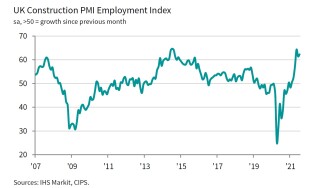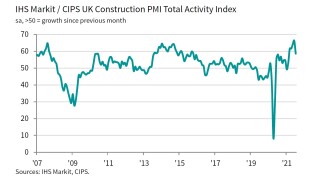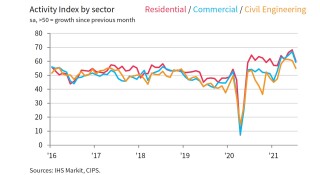The headline seasonally adjusted IHS Markit/CIPS UK Construction PMI Total Activity Index registered 58.7 in July, down sharply from June's 24-year high of 66.3.
Although the latest reading signalled the slowest overall increase in construction output since February 2021, it remains well above the crucial 50.0 no-change threshold, indicating that output is continuing to grow strongly, but just not quite as strongly as it has been in recent months.
Survey respondents often cited difficulties keeping pace with the recent surge in demand for construction projects, especially due to raw material supply shortages and shrinking sub-contractor availability.
With demand for construction materials continuing to outstrip supply, latest data signalled another steep increase in purchasing prices. Around 81% of the survey panel reported a rise in their average cost burdens during July, while only 1% signalled a decline.
All three main categories of work – house-building, commercial construction and civil engineering – reportedly saw growth slow. House building was the best-performing category in July (index at 60.3), followed closely by commercial building (59.2).
In both cases, the rate of expansion was the weakest since February. This mostly reflected stretched business capacity and growth constraints due to supply issues, the survey compilers said, but some firms noted that the post-lockdown spike in customer demand had started to wane.
Civil engineering activity (55.0) followed the momentum seen elsewhere in the construction sector during July, with growth easing sharply since June (when it scored 60.7) and at its lowest for five months.
Total order books continued to improve in July, but the latest rise in new work was the weakest since March. Similarly, input buying expanded at the slowest pace since April amid a softer recovery in demand. Construction companies also noted that reduced materials availability had acted as a brake on purchasing volumes in July.
Around 66% of the survey panel reported longer wait times for supplier deliveries in July, while only 2% signalled an improvement in vendor performance. The resulting index signalled widespread supply chain delays, although the latest reading was up from June's record low and the highest for three months. Survey respondents noted that supply imbalances were amplified by a lack of transport availability, port congestion, and Brexit trade frictions.
A rapid pace of input cost inflation continued in July, fuelled by supply shortages and robust demand for construction items. Higher charges among subcontractors and difficulties filling staff vacancies also added to price pressures. The latest decline in subcontractor availability was the second-fastest since the survey began in 1997, exceeded only by that seen during the lockdown in April 2020.
Finally, construction firms continued to hire staff at a strong pace, reflecting rising orders and confidence regarding the near-term outlook. While optimism toward future output growth remained historically high, the index drifted down to its lowest for six months in July.
Tim Moore, economics director at IHS Markit, which compiles the monthly survey, said: "July data marked the first real slowdown in the construction recovery since the lockdown at the start of this year. It was unsurprising that UK construction companies were unable to maintain output growth at the 24-year high seen in June, especially with widespread supply shortages and constrained capacity to take on additional orders. The loss of momentum spanned all major categories of construction work and was most pronounced in the house-building sector.

"Long lead times for materials and shrinking sub-contractor availability were cited as factors holding back work on site. Around two-thirds of the survey panel experienced longer wait times for supplier deliveries in July, while just 2% reported an improvement since the previous month.
"Another rapid increase in purchasing costs was linked to global supply and demand imbalances, but many firms also noted that local issues had amplified inflationary pressures. These included a severe lack of haulage availability, continued reports of Brexit trade frictions, and greater shortages of contractors due to exceptionally strong demand."
Duncan Brock, group director at the Chartered Institute of Procurement & Supply, which sponsors the survey, said: "The pace of growth in the construction sector slowed sharply in July as all three PMI surveys showed slower growth in the UK economy. The pervasive weaknesses in supply chains along with a lack of staff and contractor availability were laid bare as construction lost some of its get-up-and-go.
"The rampant rise in prices for raw materials and transportation continued to be the construction’s heavy load along with historically long delivery times. Though there was a slight improvement in supplier performance from June’s record low, it was partly as a result of frustrated supply chain managers reining back on purchases that were unlikely to arrive when needed. Businesses were also unable to expand on staff capacity, where even the most prolific hiring periods since 2014 was insufficient for builders’ ability to complete work in hand.
"Faced with transport disruptions, shortages of essentials and Brexit delays, the initial spurt of activity this year is fast hitting the rocks. Building optimism was dampened to the lowest since January as it is difficult to foresee when all these challenges are likely to subside."

Industry comment:
Matthew Farrow, policy director at the Association for Consultancy and Engineering (ACE), said: “Despite the difficult circumstances the industry is collectively facing, overall trends are still positive. However, it is also clear that the ‘perfect storm’ of Brexit trading delays, global supply pressures, and covid, is now severely impacting on construction in the UK. The industry needs to continue to work together, through forums like the Construction Leadership Council (CLC), if it is to lessen the impact of these structural issues in the coming months. This is the only way to avoid the stalling of strong post-pandemic growth.”
Fraser Johns, finance director at construction contractor Beard, said: “It’s clear that the current challenges facing the construction industry are now undermining the post-pandemic recovery we’d seen during the first half of the year. Supply chain delays, materials shortages, price rises, logistical problems, skills shortages and even the ‘pingdemic’ all conspired in July, resulting in the slowest rate of output since February. We know these are challenges that are not set to go away any time soon, so in order to move forward it’s going to be crucial to take a proactive approach.
“Working in collaboration with suppliers and subcontractors, including ensuring prompt payment, will go some way to mitigate the risk of projects falling through. But customers need to be aware of the issues facing the industry is facing as well. Being transparent at the point of submitting tenders about the need to order certain materials early to ensure delivery on time, using two stage procurement processes, will help to overcome some of these issues.”
Steve Plaskitt, partner at accountancy group MHA, said: “The construction industry is on the whole optimistic but that doesn’t mean all is rosy for all businesses. Some of the biggest current difficulties, such as supply chain challenges and staff shortages due to the ‘pingdemic’ are only temporary problems. Price pressures may be an issue as the country emerges from lockdown though; for example we are already seeing unprecedented demand for timber due to a boom in DIY.
“House prices are set to continue on the upward trajectory we have seen for over a year, despite the end of the Stamp Duty Holiday, because demand is still outstripping supply, especially outside of London and the South East. However, the outlook may not be so rosy for builders focused on city centre developments. The issue here is that city centre projects started around the time the pandemic first hit are now coming to completion. Unfortunately, because of Covid-19, there is less demand for city centre flats and offices than developers bargained for when they began these projects.
“Recently there have been early signs that some construction companies involved in these developments are starting to struggle as cash becomes tight and the furlough scheme begins to wind down. Those funding such developments will need to be patient, but inevitably, some housing schemes which will go unsold and not all businesses will survive.
“The construction sector is still not strong enough to do without government support. Many businesses are already looking with anticipation at the Chancellor’s autumn statement in a few months and hoping for some further positive news and measures to support their recovery from the Covid-19 pandemic. Developers are also drawing confidence from the fact that the economic bounce back is likely to return UK GDP to pre-pandemic levels by the end of 2021 – a whole year ahead of previous expectations.”
Got a story? Email news@theconstructionindex.co.uk





